RBSE Solutions for Class 9 Maths Chapter 9 Areas of Parallelograms and Triangles Ex 9.2
Rajasthan Board RBSE Solutions for Class 9 Maths Chapter 9 Areas of Parallelograms and Triangles Ex 9.2 Textbook Exercise Questions and Answers.
Rajasthan Board RBSE Solutions for Class 9 Maths in Hindi Medium & English Medium are part of RBSE Solutions for Class 9. Students can also read RBSE Class 9 Maths Important Questions for exam preparation. Students can also go through RBSE Class 9 Maths Notes to understand and remember the concepts easily. Practicing the class 9 math chapter 13 hindi medium textbook questions will help students analyse their level of preparation.
RBSE Class 9 Maths Solutions Chapter 9 Areas of Parallelograms and Triangles Exercise 9.2
Question 1.
In the figure, ABCD is a parallelogram, AE ⊥ DCand CF ⊥ AD. If AB = 16cm, AE = 8 cm and CF = 10 cm, find AD.
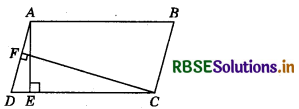
Answer:
We have Area of a ||gm = base × height
Area of ||gm ABCD = AB × AE
= (16 × 8) cm2 = 128 cm2
Area of ||gm ABCD = AD × CF
= (AD × 10) cm2
From (1) and (2), we get
128 = AD × 10
So, AD = \(\frac{128}{10}\) cm = 12.8 cm.

Question 2.
If E, F, G and H are respectively the mid-points of the sides of a parallelogram ABCD, show that ar (EFGH) = \(\frac{1}{2}\) ar (ABCD).
Answer:
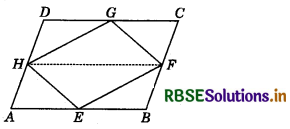
∆HGF and ||gm HDCF stand on the same base HF and lie between the same parallels HF and DC.
∴ ar (HGF) = \(\frac{1}{2}\) ar (HDCF) ........ (1)
Similarly, ∆HEF and || gmABFH stand on the same base HF and lie between the same parallels HF and AB.
ar (HEF) = \(\frac{1}{2}\) ar (ABFH)
∴ Adding (1) and (2), we get
ar (HGF) + ar (∆HEF) = \(\frac{1}{2}\) [ar (HDCF) + ar (ABFH)
or ar (EFGH) = \(\frac{1}{2}\) ar (ABCD).

P and Q are any two points lying on the sides DC and AD respectively of a parallelogram ABCD. Show that ar (APB) = ar (BQC).
Answer:
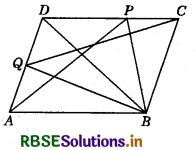
∆ APB and ||gm ABCD stand on the same base AB and lie between the same parallels AB and DC.
∴ ar (APB) = \(\frac{1}{2}\) ar (ABCD) ........... (1)
Similarly, ∆BQC and ||gm ABCD stand on the same base BC and lie between the same parallels BC and AD.
∴ ar (BQC) = \(\frac{1}{2}\) ar (ABCD)
From (1) and (2), we have :
ar (APB) = ar (BQG).
In the figure, P is a point in the ulterior of a parallelogram ABCD. Show that:
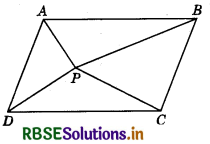
(i) ar (APB) + ar (PCD) = \(\frac{1}{2}\) ar (ABCD)
(ii) ar (APD) + ar (PBO = ar (APB) + ar (PCD)
[Hint: Through P, draw a line parallel to AS.]
Answer:
Draw EPF parallel to AB or DC and GPH parallel to AD or BC.
Now, AGHD is a ||gm [∵ GBT || DA and AG || DB]
Similarly, HCBG, EFCD and ABFE are parallelograms.
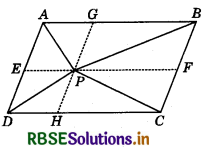
(i) ∆APB and || gm ABFE stand on the same base AB and lie between the same parallels AB and EF.
∴ ar (APB) = \(\frac{1}{2}\) ar (ABFE) ........... (1)
Similarly, ar (PCD) = \(\frac{1}{2}\) ar (EFCD) ............ (2)
Adding (1) and (2), we get
ar (APB) + ar(PCD) = \(\frac{1}{2}\) [ar (ABFE) + ar (EFCD)]
= \(\frac{1}{2}\) ar (ABCD) ......... (3)
ar (APD) = \(\frac{1}{2}\)ar (AGHD) .......... (4)
Similarly, ar (PCB) = \(\frac{1}{2}\)ar (GBCH) ............ (5)
Adding (4) and (5), we get
ar (APD) + ar (PCB) = \(\frac{1}{2}\) [ar (AGHD) + ar (GBCH)]
= \(\frac{1}{2}\)ar (ABCD) ............ (6)
From (3) and (6), we get
ar (APD) + ar (PBC) = ar (APB) + ar (PCD).
In the figure, PQRS and ABRS are parallelograms and X is any point on side BR. Show that:
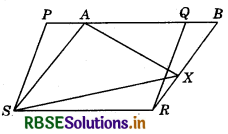
(i) ar (PQRS) = ar (ABRS)
(ii) ar (AXS) = \(\frac{1}{2}\)ar (PQRS)
Answer:
(i) ||gm PQRS and ||gm ABRS stand on the same base RS and lie between the same parallels SR and PAQB.
∴ ar (PQRS) = ar (ABRS) ............. (1)
(ii) ∆AXS and ||gm ABRS stand on the same base AS and lie between the same parallels AS and RB.
∆ ar(AXS) = \(\frac{1}{2}\)ar (ABRS)
So, ar(AXS) = \(\frac{1}{2}\)ar (PQRS) [Using (1)]
Question 6.
A farmer was having a field in the form of a parallelogram PQRS. She took any point A on RS and joined it to points P and Q. In how many parts the fields is divided? What are the shapes of these parts? The farmer wants to sow wheat and pulses in equal portions of the field separately. How should she do it?
Answer:
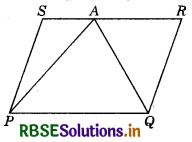
Clearly, the field, i.e., ||gm PQRS is divided into 3 parts. Each part is of the shape of a triangle.
Since ∆APQ and ||gm PQRS stand on the same base PQ and lie between the same parallels PQ and SR, therefore
ar (APQ) = \(\frac{1}{2}\)ar (PQRS) ............ (1)
Clearly, ar (APS) + ar (AQR) = ar (PQRS) - ar (APQ)
= ar (PQRS) - \(\frac{1}{2}\)ar (PQRS) [Using (1)]
= \(\frac{1}{2}\)ar (PQRS)
From (1) and (2), we get
ar (APS) + ar (AQR) = ar (APQ)
Thus, the farmer should sow wheat and pulses either as [(∆s APS and AQR) and ∆APQ] or as [∆APQ and (∆s APS and AQR) respectively.

- RBSE Solutions for Class 9 Maths Chapter 6 रेखाएँ और कोण Ex 6.3
- RBSE Solutions for Class 9 Maths Chapter 14 सांख्यिकीEx 14.3
- RBSE Solutions for Class 9 Maths Chapter 13 पृष्ठीय क्षेत्रफल एवं आयतन Ex 13.5
- RBSE Solutions for Class 9 Maths Chapter 13 पृष्ठीय क्षेत्रफल एवं आयतन Ex 13.4
- RBSE Solutions for Class 9 Maths Chapter 10 Circles Ex 10.3
- RBSE Solutions for Class 9 Maths Chapter 10 Circles Ex 10.2
- RBSE Solutions for Class 9 Maths Chapter 10 Circles Ex 10.1
- RBSE Solutions for Class 9 Maths Chapter 11 Constructions Ex 11.1
- RBSE Solutions for Class 9 Maths Chapter 9 Areas of Parallelograms and Triangles Ex 9.3
- RBSE Solutions for Class 9 Maths Chapter 11 Constructions Ex 11.2
- RBSE Solutions for Class 9 Maths Chapter 7 Triangles Ex 7.4